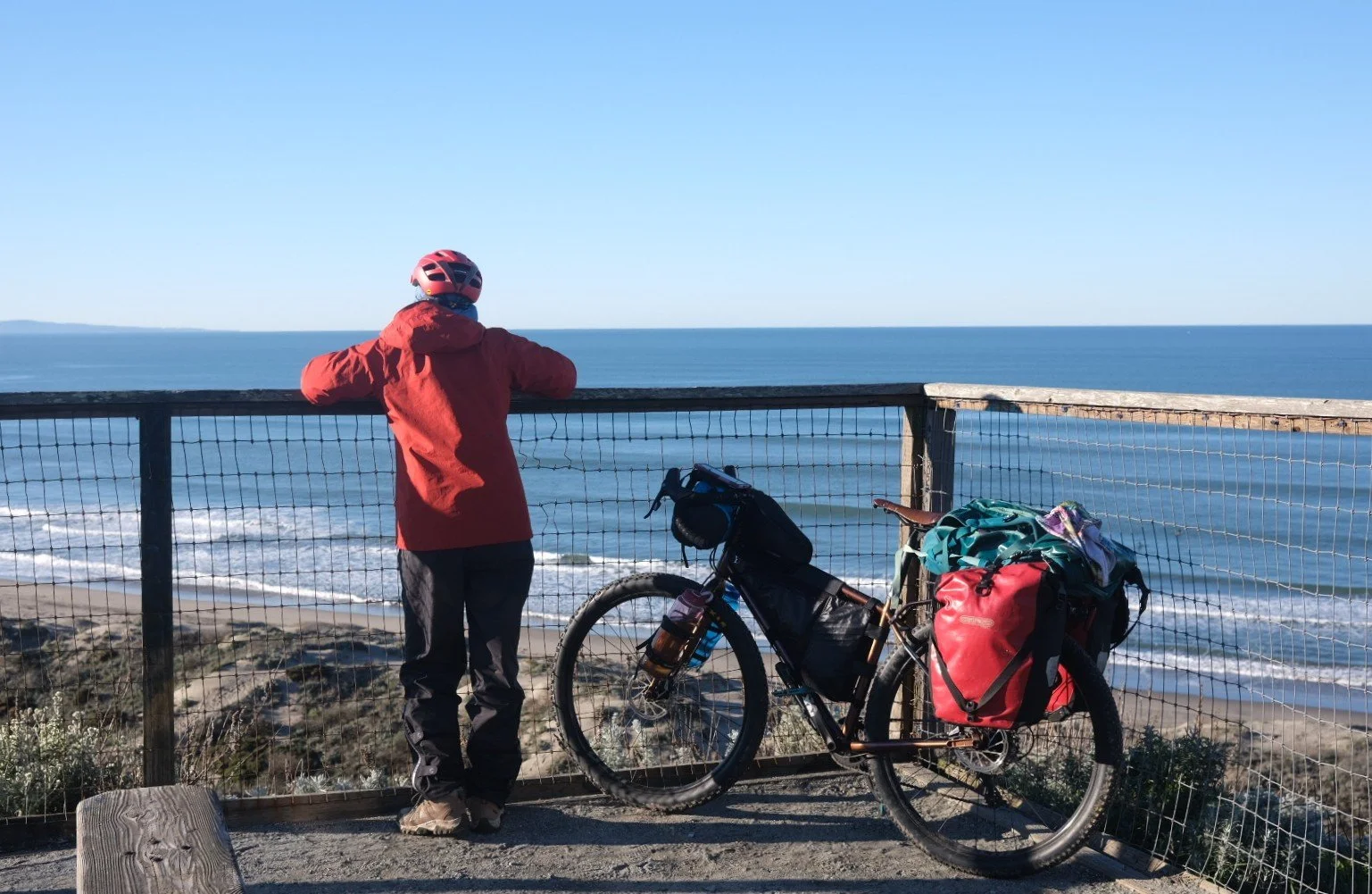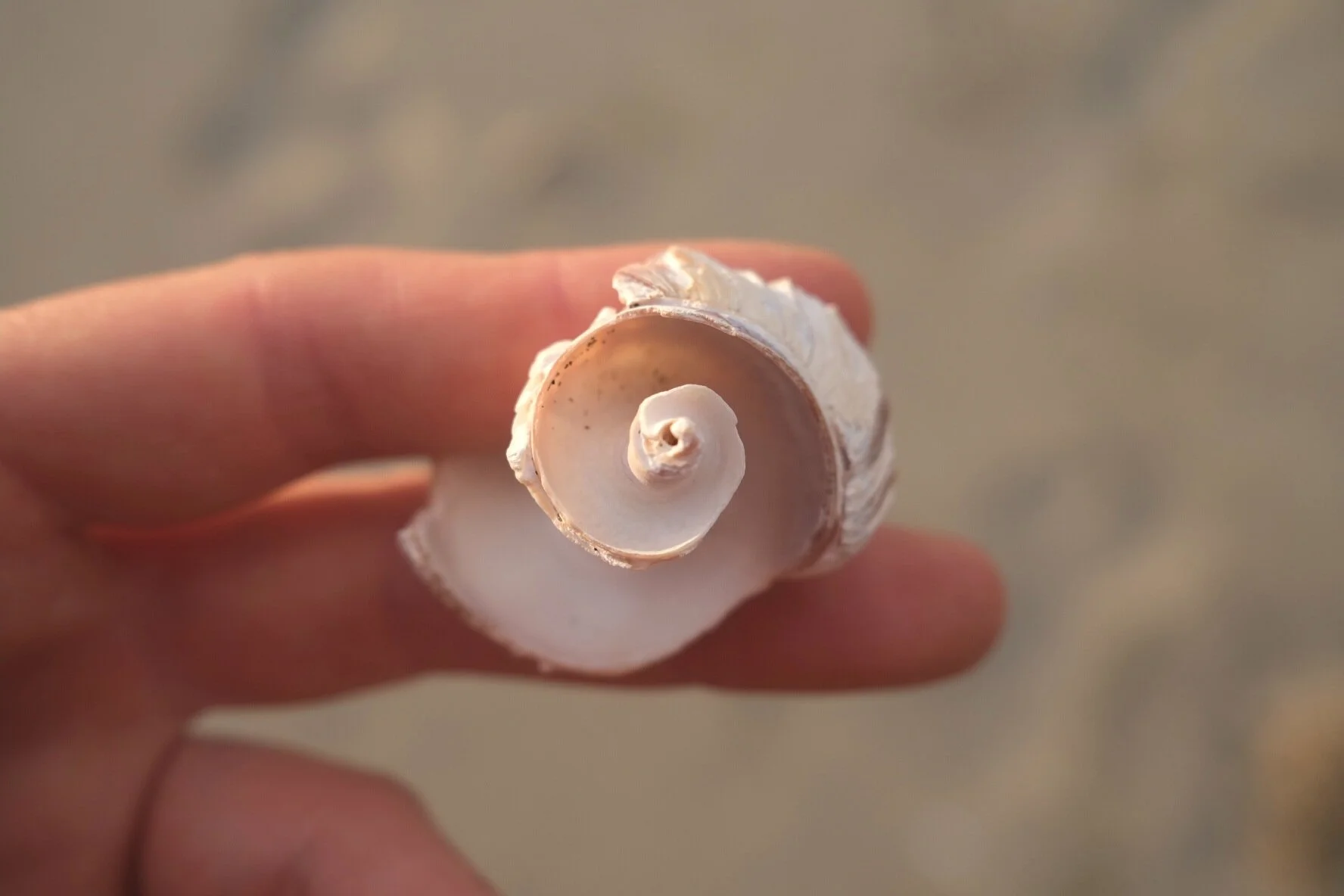Bike Camping in Cool Weather
In 2023 I decided to escape the Massachusetts winter by cycling south from San Francisco on the Pacific Coast Bike Route. I went slowly and spent time hiking, camping, spotting sea creatures, and visiting friends. It was a beautiful, meandering journey.
Between late January and late February, nightime temperatures were often in the 30s and 40s, with daytime temperatures hovering in the 40s and 50s. The weather was mostly dry and windy with occasional rain. I often woke up in the morning with my tent covered in frost, but it quickly melted as soon as the sun rose.
These weren’t harsh winter temperatures, but they weren’t easy breezy summer temperatures either! It’s what I consider “cool season” cycling and camping.
For folks living in the northern US or at higher elevations, “cool season” or “shoulder season” usually happens in the spring or fall. In the southern and/or coastal US, cool season often extends throughout the winter.
This is often a perfect time to sneak in a bike camping trip!
Cool season vibes on the Pacific Coast bike route.
Cool Season Bike Camping
Cool season bike camping has plenty of advantages. Riding temperatures are often ideal. On some routes–like the Pacific Coast Route–there’s less traffic than during the summer high season. It’s a good time to be on a bike.
Shoulder seasons are also often a time of unique environmental changes. In the spring, flowers are blooming; in the fall, you might pass rainbows of bright foliage.
The cool season along the Pacific Coast Bike Route coincides with the annual migration of sea elephants and whales, as well as breeding and birthing time for other sea mammals. It was worth the trip just to see the Año Nuevo beach filled with giant, larval-like elephant seals cuddling their pups. I felt like I had arrived at a truly special time of year.
Sweet dreams, elephant seal!
But How to Stay Warm?
The big challenge for cool season bike camping is to stay warm. When you’re working hard to pedal your bike, your body stays nice and toasty. But as soon as you stop to set up camp, your body temperature quickly falls. This usually coincides with falling temperatures as the sun goes down. It’s a double whammy.
On this trip, I spent most nights in my tent. Sometimes I camped in the same site for several days. I love camping; I also love staying warm. When I feel cozy, I feel happy.
Here are a few of my “lessons learned” about staying warm at camp in the cool season.
Layer Up: Wick, Insulate, and Protect
Pack multiple layers that you can take on and off to regulate your temperature. These include a wicking layer, one or more insulating layers, and an outer shell.
Wicking Layers (Baselayers)
If you want to stay warm in cool weather, the layer of fabric next to your skin needs to wick moisture away from you.
Within the outdoor industry there’s considerable debate about which fabrics work best to do that. Some folks swear by synthetic wicking layers like polyester; others are die-hard fans of natural fibers like merino wool. My take on it is: if lots of people love synthetics AND lots of people love wool, then either one will probably work for most people most of the time. I’ve used both with great results. On this trip I wore fast-wicking baselayers made from a merino-synthetic blend.
Insulating Layers
Insulating layers slow the transfer of heat from your body into the air around you.
Insulating layers can include wool, synthetics, down, or any other layer that helps you retain body heat. On this trip I wore a down jacket and a synthetic insulated jacket over top. On really cold nights I also used a lightweight fleece jacket and pants.
Outer Shell
An outer shell protects you from wind and rain. It also needs to let sweat and hot air vent away from your body.
Waterproof breathable rain jackets often make great outer shells. On this trip I used a Showers Pass Refuge Jacket and Showers Pass Transit Pants. I wore these a lot as windbreakers even when it wasn’t raining.
Tuck Yourself In (And Out)
Your clothes form a cocoon of warm air around your body, and any opening in that cocoon will allow heat to escape. Whenever I need to stay warmer, I tuck my shirt into my pants. If I start feeling too warm, I untuck it. This is one of the easiest ways to instantly regulate your temperature. Have you ever watched someone in long sleeves bend over, revealing two solid inches of bare skin on their back? This person has not tucked in their layers!
Other ways to “tuck yourself in” include cinching down your hood, sleeves, and pants, and making sure your jacket is fully zipped. Small changes in how you use your existing gear–like tucking, cinching, and zipping–make all the difference.
Predict Temperature Changes
When you ride your bike, your body generates a huge amount of heat. As soon as you stop, so does this additional heat source. I always pack an extra layer within easy reach, and as soon as I stop, I put on that layer. This is particularly important when I stop for the evening to set up camp and temperatures are already dropping.
In cool weather I put on a hat and extra layers as soon as I stop pedaling.
Shelter First
After I stop for the evening and put on my extra layer, I immediately set up my tent. I don’t dawdle around, make dinner, or chitchat. I really just set up that tent. Once my tent is set up, I can relax because I know I have shelter from wind and rain. It only takes a few seconds of rain to make you and your gear wet, and once you’re wet, it can take a long time to get dry again.
Prepare For Climate Chaos
During my trip to California, the weather got pretty funky. I arrived shortly after two weeks of rain and bomb cyclones closed down roads across the state. And I ended the coastal leg of my trip just before a sudden arctic freeze smothered the mountains in body-high layers of snow. In this age of climate chaos, you never know what you’re going to get. But you do know: you need to be prepared for whatever comes your way.
Each night when I set up my tent–no matter what the weather–I arrange my belongings as if it’s going to rain. I stake down my tent as if there will be wind. I prepare myself and my clothes for unexpected heat or unexpected cold.
I make sure everything that needs to stay dry will absolutely stay dry. I layer the inside edges of my tent with my empty, waterproof panniers, double check that all electronics are in plastic bags, and triple check that nothing is pressing on the edge of my tent where it could interfere with the functionality of my rain fly.
If I do wake up in the night to the patter of rain, I do another check around the edges of the tent to make sure everything is secure and dry. All this might sound obsessive, but as a solo traveler I know I’m responsible for my own safety and comfort. It’s always better to plan for bad weather than let it catch you off guard–especially when you’re sleeping.
On this trip I sometimes woke up to my bike and tent covered in frost.
The Goldilocks Effect
At a recent press trip I asked cyclist and polar adventurer Eric Larsen about his top tips for staying warm in the backcountry. His first response: don’t get too hot!
Sweat is the body’s natural cooling mechanism. So if you get too hot and start to sweat, you might end up colder than when you started.
Layering, tucking yourself in and out of your clothes, predicting temperature changes, and preparing for inclement weather are effective when your goal is a comfortable temperature balance. Larsen refers to this as the Goldilocks Effect: not too hot, not too cold, but just right. This is where you want to be. Everything in this article rests on this philosophy of balance!
Tricks of the Trade
If you’re all layered up, tucked in, well sheltered, striving for balance, and still feeling chilly, here are a few ways to turn up the heat:
Hot Water Bottle: Fill up a Nalgene or other sturdy water bottle with hot water and pop it in your sleeping bag.
Insulated Thermos: Bring an insulated thermos so you can sip hot tea throughout the day.
Snack Attack: Eat more snacks and drink more liquids: both help regulate body heat.
Have a Dance Party: Moving is guaranteed to heat you up. Even if you’re in your sleeping bag, you can still wiggle!
Bring a Heater: For short trips you can bring disposable or rechargeable hand warmers.
Listen to Your Body
Staying warm when you’re camping in cool weather is all about preparation, balance, and adopting a learning mindset. Most issues related to cold can actually be solved ahead of time by paying attention to how your body feels right now and imagining how it might feel in a little bit.
Every body is different, and bodies change over time. Fluctuations in metabolism, fitness, hormones, and even your mood can make you feel warmer or colder. Don’t let anybody tell you how you should or shouldn't feel! It doesn’t matter if the person next to you swears that they’re warm in a t-shirt–if you’re dressed in a puffy and still feel cold, your body is telling you the truth. Listen to it and take care of it. If you do, you'll probably stay a lot warmer.
A version of this article originally appeared at The Adventure Cycling Association on April 10, 2023.








